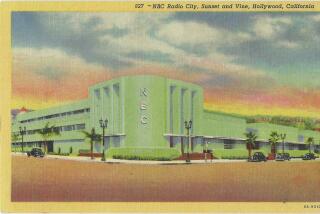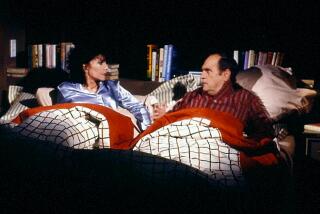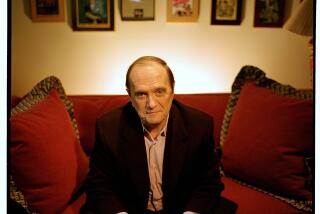Jim Hawthorne, 88; comically outrageous radio, TV personality
Jim Hawthorne, the wacky and wildly inventive Los Angeles radio and television personality who turned traditional post-World War II broadcasting on its ear, has died. He was 88.
Hawthorne, who had congestive heart disease, died Nov. 6 at a skilled nursing and rehabilitation center in Santa Barbara, said his son Scott.
The Colorado-born Hawthorne came to fame in 1947 on Pasadena radio station KXLA (now KRLA) when, as Time magazine reported a year later, he “suddenly turned his show into a carefree, wit-loose ‘Hellzapoppin on the air.’ ”
Listeners to his nighttime show never knew what to expect from the comically outrageous and unpredictable Hawthorne.
He might suddenly interrupt a record with a voice that said, “I’ve got cole slaw in all my pockets. I’m cold.”
And he once played 10 minutes of Bach, which he interlaced with assorted comments and the sound of a barking seal.
The off-beat Hawthorne voiced a slew of characters that populated his show, including Skippy (a mischievous old man who made fun of him), Eggbert (his “engineer”) and Scrappy (an aptly named piece of paper he’d carry on conversations with by crinkling it against the microphone).
Hawthorne would introduce commercials by banging two cymbals together. Then he might play the commercials at extremely slow or extremely fast speeds.
He did the same with records and, if he was really bored with one, he’d drag the needle across it.
Hawthorne created his own world with his own lingo that was quickly picked up by his fans. His biggest catchword was “hogan.” As in “Pasadena-hogan” and “hoganburger.”
His listeners were dubbed Hoganites. And Hawthorne plunked a fan-created instrument called the Hogantwanger -- a series of hacksaw blades cut to different lengths and mounted on a wooden base. He even wrote and recorded a musical tribute to the “hogan” phenomenon, “The Hogan Song.”
Musically, Hawthorne served up an eclectic playlist that included records by Spike Jones, Homer and Jethro, Buddy Baker, Red Ingle and Slim Coates -- as well as antique records from the 1910s by pioneering recording artists Arthur Pryor, Billy Murray and Prince’s Band, whose “So Long Letty” became Hawthorne’s theme song.
“He was one of a kind,” Barry Hansen, the syndicated radio host known as Dr. Demento, told The Times this week. “There was no one else like him on the radio at that time -- totally free-form, off-the-wall, and making great use of humor.”
In 1950, Hawthorne produced and starred in “The Hawthorne Thing,” a Saturday night radio show that originated at NBC’s Hollywood studio and was broadcast coast to coast.
Hawthorne was a natural for television.
From 1950 to 1952, he hosted “This Is Hawthorne,” a late-evening TV talk show on KLAC-TV (now KCOP-TV Channel 13). He also did TV shows on Channels 5 and 2.
He proved to be as innovative on television as he had been on radio.
“Eggbert” resurfaced as the name Hawthorne gave to the camera, whose operator was given free rein to roam the set. In the middle of one of Hawthorne’s zany routines, Eggbert might follow a fly across the ceiling -- or zero in on the legs of a pretty woman in the studio audience.
In Steve Allen’s book “Hi-Ho Steverino: My Adventures in the Wonderful Wacky World of TV,” he said he sometimes referred to Hawthorne as “the West Coast Ernie Kovacs since both men specialized in fresh, inventive sight gags and camera tricks, rather than simply doing radio comedy on TV as other comedians of that time did.”
During the late ‘40s and ‘50s, Hawthorne turned out a number of records, including the hit “Serutan Yob,” a 1948 hillbilly-style parody of Nat King Cole’s popular song “Nature Boy.”
In 1952, he launched “Hawthorne Looks at the Weather,” a daily five-minute comedic weather segment on what is now KNBC-TV Channel 4. He later did a weather spot on KTTV-TV Channel 11.
Hawthorne was born in Victor, Colo., on Nov. 20, 1918. While attending Denver University, he got his first job in radio in 1940 at KMYR. After a brief stint in the Army, he moved to Los Angeles, where he landed a job as assistant director on the Range Busters westerns before joining KXLA in 1943. He later served as program director and show host at radio station KFWB.
In 1965, Hawthorne moved to Honolulu, where he created and briefly served as the original host of “Checkers and Pogo,” a popular, long-running children’s TV show. He also became involved with programming at Honolulu radio station KGMB.
After moving back to Denver in 1970, he served as promotion director and program director at radio station KOA, and he created, wrote and hosted a daily news magazine for KOA-TV. He retired in 1985 but continued to make appearances on radio over the years and also wrote a Web column for a Los Angeles radio page.
For the last few years, Hawthorne was a resident of the Buena Vista Care Center in Santa Barbara, where he produced several local cable-access variety shows.
The shows featured the talents of staff members and fellow residents and their children.
“He just had fun down to the very end,” his son said.
In addition to son Scott, Hawthorne is survived by his other son, Darr; and five grandchildren. His daughter, Deone, died in 1994.
A memorial service in Los Angeles is pending.
--
More to Read
Sign up for Essential California
The most important California stories and recommendations in your inbox every morning.
You may occasionally receive promotional content from the Los Angeles Times.










